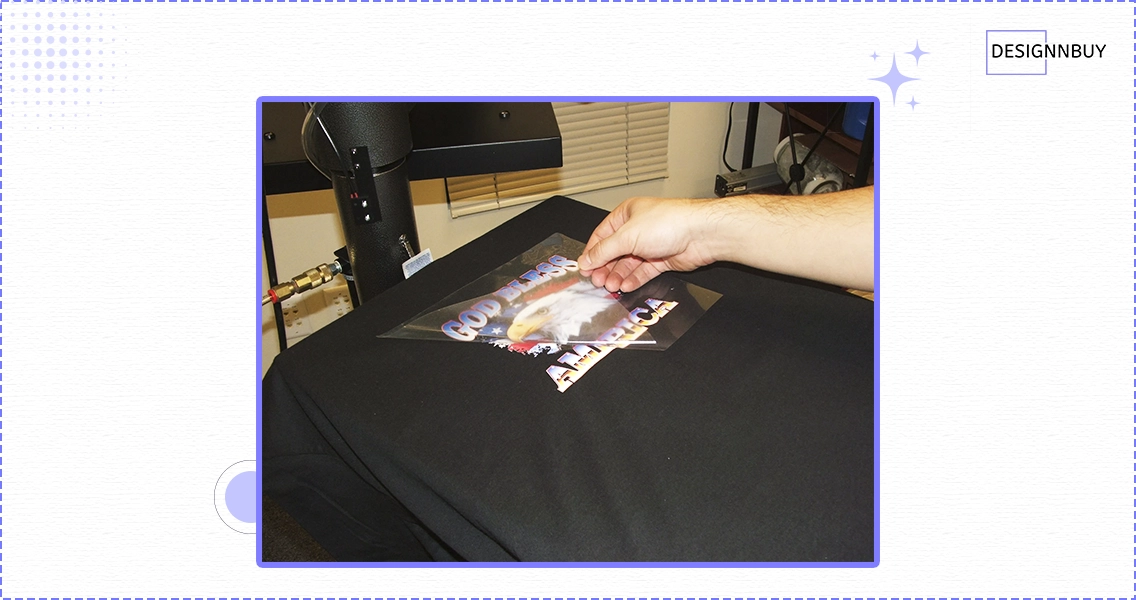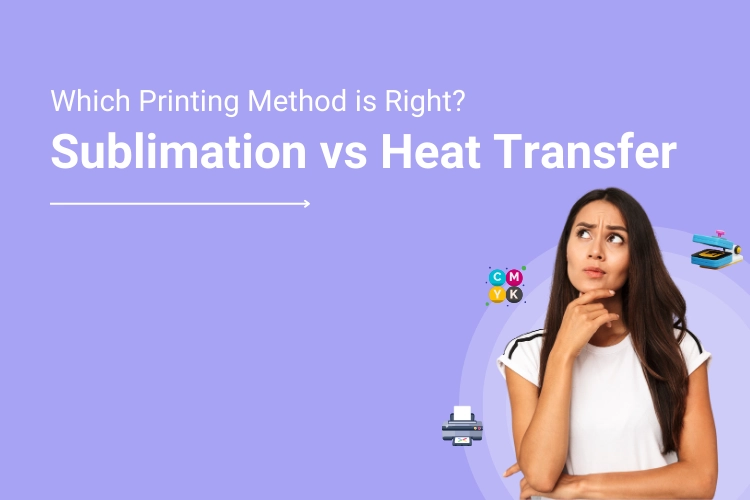The print business is a thriving space to be in right now — people are always on the lookout for customized products, and high-quality stationery, wearables, and accessories with unique designs are trendy.
Besides, according to a Smithers report, the global printing market is predicted to be valued at $821 million this year. The technology used by printers is also changing — whether it is web-to-print solutions or printing techniques.
If you are planning to add personalized garments to your product portfolio, there are two sublimation and heat transfer printing methods that you can opt for — heat transfer printing and sublimation printing.
Both have their respective pros and cons, and you can choose either as you like. Here is a short guide to help you decide on your online design studio:
Table of Contents
What is Heat Transfer Printing?

Heat transfer printing uses a particular type of paper that transfers a printed design to a garment surface when the heat is applied. You use a laser or inkjet printer to print the design onto the heat transfer paper.
It is then placed on the garment surface and pressed with a heat press (a home iron will do at a pinch too). Afterward, the paper is peeled off, and the image adheres to the garment surface. Is it not fascinating?
Heat transfer printing is one of the simplest and cheapest ways to start with custom garment printing, and many print businesses begin with just the printer they have at home. It is the perfect choice for home entrepreneurs.
What is more — you can use this method for both cotton and polyester fabric and both dark and light-colored garments.
What is Sublimation Printing?

The sublimation printing process is almost like that of heat transfer printing — the design is printed onto sublimation paper, to which heat is then applied. The difference is in how the science of sublimation works.
When you heat sublimation ink, it turns into a gas from a solid-state and embeds itself into the fabric. Once it cools, the gas goes back to solid but becomes a part of the material permanently.
Your transferred design feels the same as the rest of the garment — there is no added layer on top. The design is also highly durable and can last as long as the garment itself under regular conditions.
Sublimation printing can only be used on polyester garments (not cotton), but you can also use it on hard objects with poly-coating, such as mugs, jewelry, or coasters.
Heat Transfer Printing vs. Sublimation Printing
When you start in the garment printing business, it is best to pick one of these two sublimation vs heat transfer printing methods and invest in it. Here, we discuss the start-up considerations for each to help you choose wisely that is both efficient and economical:
1. Costs and equipment
Heat transfer printing is exceptionally cheap to start with, as you can make do with any inkjet or laser printer you have at home.
Besides, you will need the heat transfer paper, the garments you will be decorating, and a heat press, which you can get for around $300 to start with.
Sublimation printing is more expensive by contrast, although it has reduced in recent years, and the cost of the heat press remains the same.
A cost-effective option is to invest in a sublimation printing starter kit, which comes with the sublimation printer, the paper, the necessary sublimation design software, and a sample set of products to print on.
2. Feel and durability
With sublimation, the printed design becomes an actual part of the fabric rather than a layer on top, which means you get a superior feel to the garment and unmatched durability.
With heat transfer printing, you can feel the layer on top, and it can get cracked or faded with multiple washes. However, by investing in higher-quality heat transfer papers and heat transfer software, you can achieve and sell print items with a softer feel and more durability — relatively quickly.
3. Types of garments you can make
Sublimation ink will only bind to polyester material, so you cannot use it on 100% cotton garments. You can work with poly-cotton materials to some extent, but the transfer quality would not be quite as vibrant.
Plus, since sublimation does not involve any extra layers on top of the fabric, you need to work with white or light-colored garments for the design to show up clearly.
On the other hand, heat transfer printing works for garments in all colors and polyester, cotton, and blended fabrics.
4. Colors produced
Sublimation printing lets you pick full colors, making it ideal if you want to create a specific design, like a brand logo or a photograph. Heat transfer printing may not always produce the same full-color effect.
If you want to print photos or logos through heat transfer, you will need to invest in higher-quality heat transfer paper. Inkjet transfer papers are typically your best bet for photo printing. Implement a web to print software and start selling today!
5. Weeding
With sublimation printing, the design is directly transferred to the fabric, so the process is naturally self-weeding. Heat transfer papers are typically not self-weeding except for certain “two-step” laser transfer papers.
That means that with most heat transfer papers, there will be a prominent background in the paper’s shape around the design.
You will need to trim around the image to get rid of this background, particularly for dark-colored fabrics where it will show up clearly. With white or light-colored fabrics, the background is less visible, although you will still be able to feel it physically.
Conclusion: Heat transfer vs. sublimation: Which is better?
According to us, sublimation printing is the perfect choice for you if you want your printing business to scale massively. But if budget is an issue, then heat transfer printing is not a bad option either.
In the print industry context, having an online web2print design tool can make all the difference. The innovative technology will help you set up an eCommerce storefront, and you can sell multiple custom print-ready templates for products you like to your customers.
FAQs on Heat Transfer and Sublimation Printing
What is sublimation printing vs. Cricut?
Sublimation printing is a process where heat and pressure are used to turn dye into gas, which then bonds with polyester fabric or coated surfaces. It’s perfect for vibrant, long-lasting full-color prints.
Cricut, on the other hand, is a brand of cutting machines used for craft projects like vinyl decals, iron-on transfers, and paper crafts. It works with pre-printed or pre-colored materials—it doesn’t print, but cuts shapes or letters for applying.
What's the difference between sublimation and vinyl?
Sublimation infuses ink directly into the fabric or coated surface, making the design permanent, soft to the touch, and highly durable—ideal for polyester apparel and mugs.
Vinyl printing (or heat transfer vinyl) involves cutting designs from colored vinyl sheets and heat pressing them onto the surface. The design sits on top of the material and can peel or crack over time.
Can sublimation ink be used on heat transfer paper?
No, sublimation ink should be used only with sublimation paper. Heat transfer paper is designed for inkjet or laser printers with standard inks, not sublimation inks. Mixing them can damage your printer or result in poor-quality prints.
What is sublimation on a t-shirt?
Sublimation on a t-shirt involves printing a design with sublimation ink onto special paper, then using a heat press to transfer the design into the fabric. It works best on light-colored, 100% polyester shirts and results in vibrant, no-feel prints that won’t crack or fade.
Is sublimation good for printing?
Yes, sublimation is excellent for printing vivid, high-resolution, full-color designs on suitable materials. It’s ideal for printing apparel, mugs, signs, and promotional items—especially when long-lasting results are important.
Is heat transfer good for printing?
Yes, heat transfer is a versatile and beginner-friendly method for applying graphics to a variety of surfaces. While it may not last as long as sublimation, it’s ideal for cotton fabrics and dark materials, offering flexibility in design options.
What is needed for sublimation printing?
To start sublimation printing, you’ll need:
A sublimation printer (or a converted inkjet printer)
Sublimation ink
Sublimation paper
Heat press machine
Sublimation-compatible blanks (polyester garments, coated mugs, etc.)
Design software (like DesignNBuy’s sublimation printing software
Can I use both methods for my printing business?
Many businesses use sublimation and heat transfer methods to offer their customers a wider range of customization options.
What is needed for heat transfer printing?
For heat transfer printing, you’ll typically need:
An inkjet or laser printer
Heat transfer paper (specific to the printer type)
A heat press or iron
Blank materials like cotton shirts, totes, or other fabrics
Design software for creating artwork
What paper is used for sublimation printing?
Sublimation paper is specially coated to hold sublimation ink and release it efficiently when heat is applied. It ensures sharp image transfer and bright colors. It’s not the same as regular inkjet or heat transfer paper and must be used for sublimation results.
Check out some of our other great content here
- Offset Printing vs Digital Printing: Pros, Cons, and Considerations
- What Is Variable Data Printing? 2025 Guide for Print Businesses
- DTF Printing: How to Start & Succeed in the Business
- 10 Best T-Shirt Design Software Options in 2025
- Print Finishing Techniques: Top Options and How To Choose
*This blog post was last updated in July 2025.

